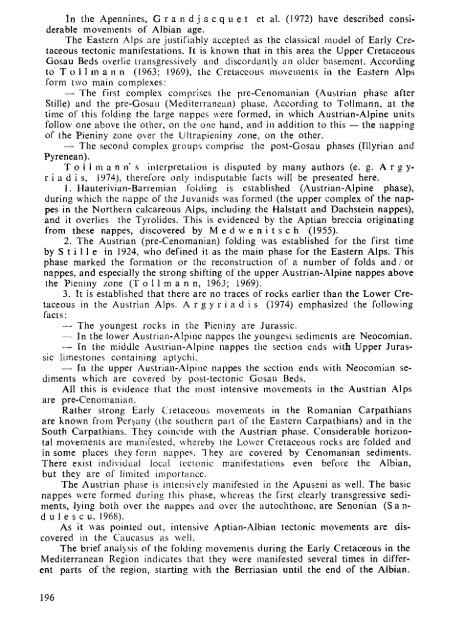THE MEDITERRANEAN LOWER CRETACEOUS
THE MEDITERRANEAN LOWER CRETACEOUS
THE MEDITERRANEAN LOWER CRETACEOUS
Create successful ePaper yourself
Turn your PDF publications into a flip-book with our unique Google optimized e-Paper software.
In the Apennines, Grand jacquet et al. (1972) have described considerable<br />
movements of Albian age.<br />
The Eastern Alps are justifiably accepted as the classical model of Early Cretaceous<br />
tectonic manifestations. Tt is known that in this area the Upper Cretaceous<br />
Gosau Beds overlie transgressively and discordantly an older basement. According<br />
to Toi 1 m an n (1963; 1969), the Cretaceous movements in the Eastern Alps<br />
form two main complexes:<br />
—• The first complex comprises the pre-Cenomanian (Austrian phase after<br />
Stille) and the pre-Gosau (Mediterranean) phase. According to Tollmann, at the<br />
lime of this folding the large nappes were formed, in which Austrian-Alpine units<br />
follow one above the other, on the one hand, and in addition to this — the napping<br />
of the Pieniny zone over the Ultrapieniny zone, on the other.<br />
— The second complex groups comprise the post-Gosau phases (Illyrian and<br />
Pyrenean).<br />
Tollman n' s interpretation is disputed by many authors (e. g. A r g yr<br />
i a d i s, 1974), therefore only indisputable facts will be presented here.<br />
1. Hauterivian-Barremian folding is established (Austrian-Alpine phase),<br />
during which the nappe of the Juvanids was formed (the upper complex of the nappes<br />
in the Northern calcareous Alps, including the Halstatt and Dachstein nappes),<br />
and it overlies the Tyrolides. This is evidenced by the Aptian breccia originating<br />
from these nappes, discovered by M e d w e n i t s с h (1955).<br />
2. The Austrian (pre-Cenomanian) folding was established for the first time<br />
by S t i 11 e in 1924, who defined it as the main phase for the Eastern Alps. This<br />
phase marked the formation or the reconstruction of a number of folds and / or<br />
nappes, and especially the strong shifting of the upper Austrian-Alpine nappes above<br />
the Pieniny zone (Tollmann, 1963; 1969).<br />
3. It is established that there are no traces of rocks earlier than the Lower Cretaceous<br />
in the Austrian Alps. Argyriadis (1974) emphasized the following<br />
facts:<br />
— The youngest rocks in the Pieniny are Jurassic.<br />
— In the lower Austrian-Alpine nappes the youngest sediments are Neocomian.<br />
— Tn the middle Austrian-Alpine nappes the section ends with Upper Jurassic<br />
limestones containing aptychi.<br />
— In the upper Austrian-Alpine nappes the section ends with Neocomian sediments<br />
which are covered by post-tectonic Gosau Beds.<br />
All this is evidence that the most intensive movements in the Austrian Alps<br />
are pre-Cenomanian.<br />
Rather strong Early Cretaceous movements in the Romanian Carpathians<br />
are known from Persany (the southern part of the Eastern Carpathians) and in the<br />
South Carpathians. They coincide with the Austrian phase. Considerable horizontal<br />
movements are manifested, whereby the Lower Cretaceous rocks are folded and<br />
in some places they form nappes. They are covered by Cenomanian sediments.<br />
There exist individual local tectonic manifestations even before the Albian,<br />
but they are of limited importance.<br />
The Austrian phase is intensively manifested in the Apuseni as well. The basic<br />
nappes were formed during this phase, whereas the first clearly transgressive sediments,<br />
lying both over the nappes and over the autochthone, are Senonian (Sand<br />
u 1 e s с u, 1968).<br />
As it was pointed out, intensive Aptian-Albian tectonic movements are discovered<br />
in the Caucasus as well.<br />
The brief analysis of the folding movements during the Early Cretaceous in the<br />
Mediterranean Region indicates that they were manifested several times in different<br />
parts of the region, starting with the Berriasian until the end of the Albian.<br />
196

















